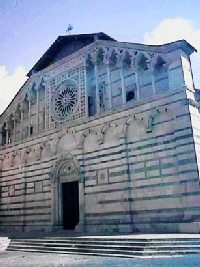
The Duomo is situated in the center of the old town, amidst medieval buildings. Built entirely with white marble from the 11th to the 14 centuries, it's rectangular in shape, with nave, two aisles and semicircular apse. It's dedicated to Saint Andrew and subsequently has been dedicated to Saint Mary too.
Its harmonious architecture is a masterly blend of different styles: the façade, Pisan-Romanesque in the lower section (11th century) and Gothic in the upper part (mid 14th century), contains the rose window, the main architectural and decorative feature, which mingles the Gothic and Byzantine styles. The wheel window, called "rôta d'l Dom" ("The wheel of the Duomo") by the inhabitants of Carrara, is made up of small smooth and spiral columns in radial arrangement inside a marble square divided in coffers decorated in the central part with open lozenges. Eight figures from the Old testament are placed above the columns. The plaster molds and marble copies of the statues are kept in the Museo Civico del Marmo as possible future substitutes. The 33 meter high bell tower has mounting apertures on the four floors and a pyramid top.
Inside the church there are 6 minor altars from various periods as well as the relief white statuary marble high altar, a polychrome marble pulpit, two statues of the Annunciation, Saint Ceccardo's urn, a series of sculptures of the dismantled high altar by Guardi, a wooden crucifix by Puccinelli, some statues in niches along the walls, two white marble holy water fonts and a series of rather damaged frescoes on the side walls. The Duomo and its annexes offer a view of the uses of Carrara marble through the centuries: as functional building material of the actual structure, for decoration purposes, for full, bas and high relief sculptures, inlays, furnishings and ornaments for indoor and outdoor.